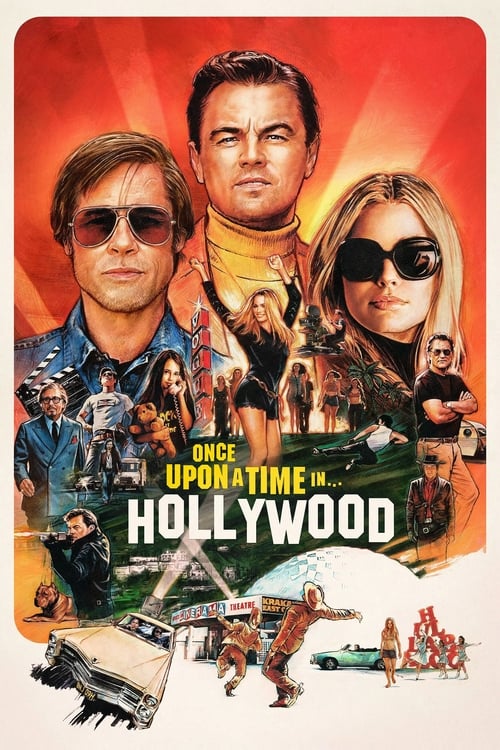Once Upon a Time... in Hollywood

Plot
Set against the vibrant backdrop of 1960s Los Angeles, Quentin Tarantino's Once Upon a Time... in Hollywood is a nostalgic and poignant exploration of the fragility of stardom, the blurring of reality and fantasy, and the merciless onslaught of time. The film's nonlinear narrative seamlessly weaves two distinct storylines, deftly navigating the boundaries between fact and fiction. At the heart of the film is Rick Dalton, a once-bright television star who has been relegated to the dusty hinterlands of small-screen Westerns. Played by Leonardo DiCaprio, Dalton is a man struggling to adapt to a rapidly evolving film industry, desperate to command the respect of his peers and the adoration of his audience. His insecurities are compounded by his stagnating career, and he finds solace in his friendships with those he believes truly understand him. Stuntman Cliff Booth, played by the incomparable Brad Pitt, is Dalton's confidant and trusted sidekick, an enigmatic figure whose dark past and troubled present threaten to derail his own aspirations. The bond between Dalton and Booth is cemented by a shared desire to cling to the Hollywood they once knew, the excitement that coursed through their veins when they first arrived in Tinseltown. Booth's symbiotic relationship with his tranquilization-trained pit bull, Brandy, serves as a metaphor for his primal, instinctual existence, oscillating between tenderness and ferocity. As Dalton faces an uncertain future, he nurses a strained relationship with the film industry's slick and ruthless executives, who view him as a relic of a bygone era. In a world that prizes daring innovation and risks, Dalton's penchant for comforting familiarity makes him an anachronism. Against this bleak backdrop, the once-beloved actor's dwindling profile begins to fuel a sense of self-doubt, as he repeatedly mulls over an ill-fated career past. Dalton's neighborhood in Los Feliz serves as the film's hub, nestled among picturesque bungalows and verdant parks. He lives adjacent to the property of the celebrated director Roman Polanski and his fledgling actress wife Sharon Tate. As a kind of counterpoint, the couple project an aura of effortless glamour, blissfully content in each other's company. Tate, a sweet and gentle soul, is constantly fawned over by fans and the adoring media, highlighting the artificial, confining atmosphere surrounding the superstar's 'perfection.' Despite her beauty and fame, Tate exudes an unassuming quality that testifies to the fragility of the spotlight's fleeting appeal. Simultaneously, the world around them is transforming at breakneck speed. The Hollywood establishment grapples with commercial demands and shifting tastes, propelling icons like Dalton and Polanski inexorably toward extinction. Even beyond the closed doors of Hollywood, cultural revolutions and historical upheavals in 1969 – in part provoked by the Vietnam War – manifest in turmoil. As Polanski becomes increasingly absorbed by his meticulously choreographed sets and dramatic reenactments, their 20-year-old marriage starts crumbing. Tara, their adorable daughter, serves as a counterbalance to the declining bond between her parents. The seemingly straightforward dynamic between the artistic couple and the newlywed home reveals signs of a precarious psychological struggle when Polanski frequently stays late at work. Tarantino brings authenticity to his period drama by populating the background scenes with a genuine assortment of famous and genuine personalities that inhabited this Hollywood era. This film transports the viewer to that specific year of La La Land – an exuberant fusion of optimism and jolted reality where Los Angeles transformed into a veritable funhouse of promise and uncertainty.
Reviews
Recommendations




